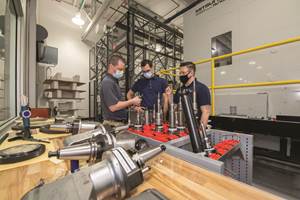Center of Excellence Is New Twist on Old Manufacturing Department Structure
The new Spirit AeroSystems facility for five-axis machining allows a small team to oversee a significant amount of machining capability. Is this the way of the future as machining systems become more automated?
There was a time when machine shops were routinely organized by operation. There were separate departments for turning, milling, grinding and so on. The arrangement was meant to bring together people who were alike in their specialization by equipment type. By contrast, cross-training and diverse equipment are more valued in shops today. Though similar machines might locate near one another, a variety of machines fill the shop, and employees are valued for their ability to engage across that variety.
Yet Spirit AeroSystems is going a different way, at least partially.
On a tour of the company’s manufacturing campus in Wichita, Kansas, I got to visit its newly opened Five-Axis Machining Center of Excellence. A similar center for three- and four-axis work is in Oklahoma. These facilities bring like machining capability together, along with people dedicated to this capability. The sense of concentration at the Witchita center was clear: It was just five-axis and nothing else. Is this a step backward?
Actually, no. It is an advance in line with ways machining technology is advancing. It may even offer a glimpse of the way machine shops will routinely operate not far in the future.
A striking contrast illustrates the center’s value. The Wichita site is expanding. It makes commercial aircraft fuselages (among other aircraft systems), and though one major plane model has seen an unexpected decline in orders this year, the trend overall for Spirit has been a challenge to increase production, and therefore increase personnel. The company had aimed to add 1,000 new employees this year (unknown whether recent events affect that plan). Yet here is the contrast: The personnel needs of the new five-axis center are slight by comparison. There are various types of five-axis machines here, but much of the machining is performed on two integrated pallet cells consisting of six Makino Mag 3 machining centers apiece. The cells each require one operator per shift, for a total of six operators, with three more providing buffer. Therefore, nine operators are enough to staff the two cells’ 12 machines around the clock. Suffice it to say, of the 1,000 new hires, few or none will be needed on these cells.
The center of excellence concept creates capacity, most basically in floor space. Concentrating five-axis into one place is more space-efficient than the previous arrangement of dispersed five-axis capability. It also creates productive capacity because the five-axis specialists assembled here now have an easier time coordinating to address challenges. Moreover, they can give their attention to more machines apiece. There are many more people here than just those on the pallet cells, but still, the team here is few but mighty. And Spirit AeroSystems is poised to capitalize on that might. One reason for increasing capacity is the company’s hope to raise contract machining alone into a $1 billion business.
Relatively few manufacturers will have the chance to invest in a six-machine cell on the order of what this site has, let alone more than one of them. But increasingly automated systems are the reality of almost any shop that is continuing to update its technology. In a shop with ever more automation, the challenge is to see just how much machining capacity a knowledgeable operator might be able to oversee and what arrangement will address this challenge best. The model of concentrating capability is therefore liable to make a comeback, but no longer as much for the sake of bringing together people doing similar work. That’s part of it, but the benefit now is much more about bringing all the equipment and capability together around these people.
Related Content
Lean Approach to Automated Machine Tending Delivers Quicker Paths to Success
Almost any shop can automate at least some of its production, even in low-volume, high-mix applications. The key to getting started is finding the simplest solutions that fit your requirements. It helps to work with an automation partner that understands your needs.
Read MoreFearless Five-Axis Programming Fosters Shop Growth
Reinvestment in automation has spurred KCS Advanced Machining Service’s growth from prototyping to low-and mid-volume parts. The key to its success? A young staff of talented programmers.
Read MoreDigital Twins Give CNC Machining a Head Start
Model-based manufacturing and the digital thread enable Sikorsky to reduce lead times by machining helicopter components before designs are finalized.
Read MoreHow to Successfully Adopt Five-Axis Machining
While there are many changes to adopt when moving to five-axis, they all compliment the overall goal of better parts through less operations.
Read MoreRead Next
3 Mistakes That Cause CNC Programs to Fail
Despite enhancements to manufacturing technology, there are still issues today that can cause programs to fail. These failures can cause lost time, scrapped parts, damaged machines and even injured operators.
Read MoreThe Cut Scene: The Finer Details of Large-Format Machining
Small details and features can have an outsized impact on large parts, such as Barbco’s collapsible utility drill head.
Read More
.jpg;width=70;height=70;mode=crop)







.jpg;maxWidth=300;quality=90)

















